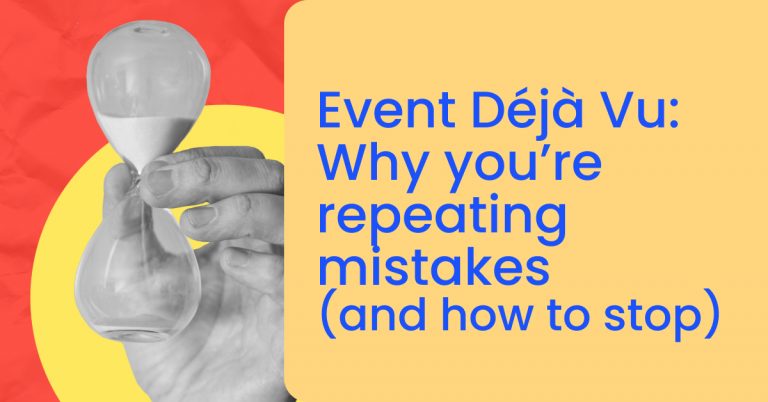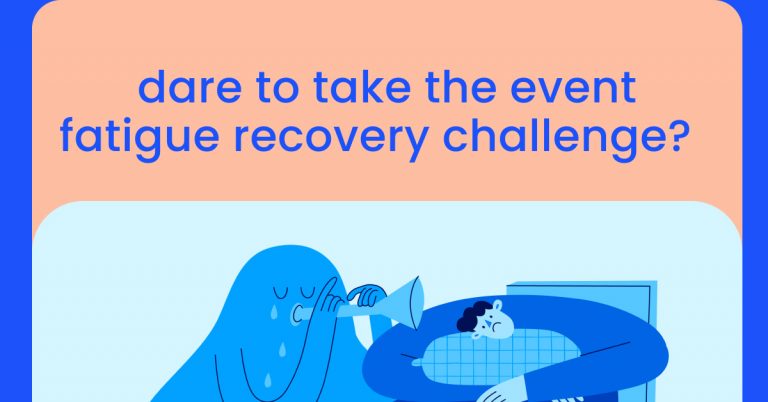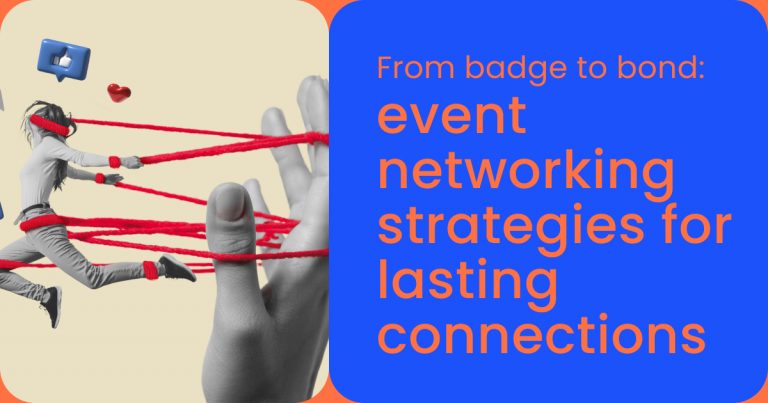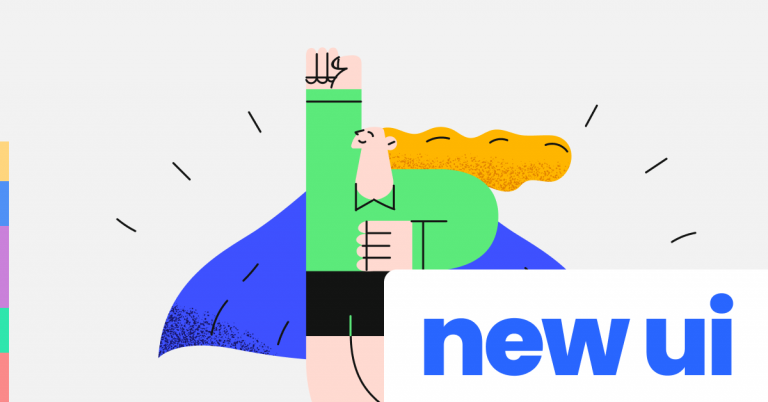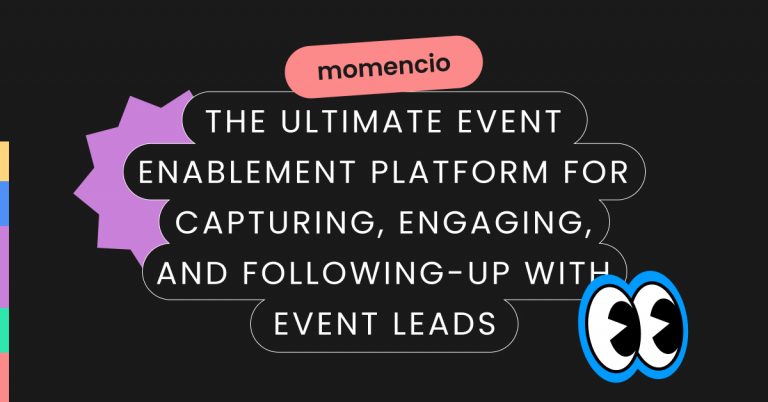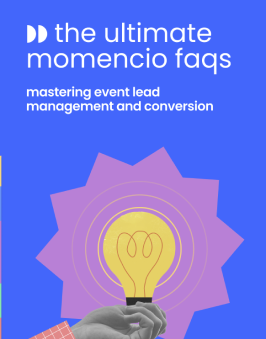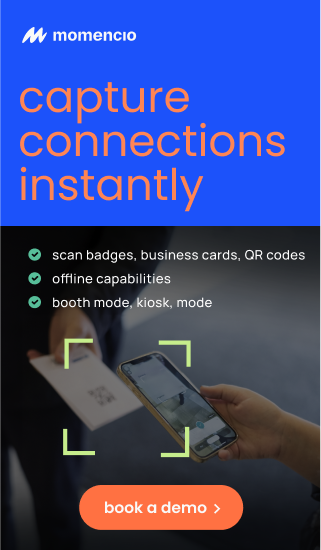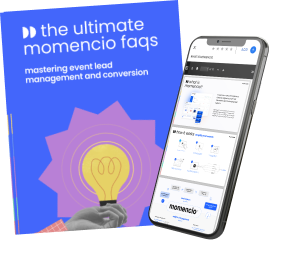Most people don’t talk about it openly, but if you’ve ever worked a trade show floor or stood under the bright lights of an event booth, you know exactly what I’m about to say.
The biggest challenge isn’t getting people to stop by. With a decent booth, some snacks, or a clever giveaway, you’ll get the foot traffic. The real problem is what happens next.
Because every face that smiles at you, every badge you scan, feels like a win in the moment. But then you go back to the office, load up your leads, and realize something harsh. Most of them aren’t really leads at all. They were just conversations. Polite chats. A quick swag grab on the way to their actual destination. And suddenly, all that energy you poured into the event feels like a slow deflation.
You wonder: was it the scanner? Was it my pitch? Did I ask the wrong questions? Why did it feel so good at the event but so hollow when I got back?
Most event teams are trapped in a bad system. They capture leads because they’re told to. They scan badges because they can. But they rarely have a clear plan for how to separate real buyers from time-wasters while they’re still on the floor. And by the time they try to do it back at their desk, it’s too late. The spark is gone.
There’s also a deeper frustration here. Nobody tells you this before you step onto that show floor. Most training focuses on features and demos, not field reality. They tell you how to scan a badge. They don’t tell you how to read the person’s eyes when you’re halfway through your pitch and realize they’re just being polite. They tell you how to follow up. They don’t tell you which conversations aren’t worth following up on at all.
And let’s be honest. There’s a kind of pressure at events that no one admits to. The need to “show numbers.” To come back with a thick lead list, to prove you were busy, to make the booth seem like a success on paper. But volume is a liar. A list of 500 unqualified leads is just a list of dead ends wearing nametags.
This is where sharp event sales qualification changes everything.
Because qualification, done well, doesn’t slow you down. It actually speeds you up. It protects your time, your budget, your sanity. It helps you focus your limited attention on the prospects who matter most, while politely stepping away from the ones who don’t.
And here’s the thing. You don’t need more tools. You don’t need flashier scanners. You need a way of thinking. A mental framework you carry into every conversation at the event. A way to listen between the lines, to guide the flow of dialogue so that people naturally reveal their true intentions — without them feeling like they’re being vetted.
That’s what we’re going to do here.
We’re going to talk about the signals to watch for, the questions to ask, and the moments when you’ll know it’s time to move on. We’re not here to fill your CRM with noise. We’re here to fill your pipeline with prospects that are worth your time, your energy, and your follow-up.
If you’ve ever left an event feeling like you worked ten times harder than the results show, this one’s for you.
What is event sales qualification and why does it matter?
Let’s clear something up before we go any further. Event sales qualification is not about running a mental checklist while you talk to someone at your booth. It’s not a script. It’s not a game of twenty questions. And it’s definitely not about fast-talking your way through conversations just to hit some lead quota.
Event sales qualification is the quiet skill of figuring out — in the flow of conversation — if the person in front of you is worth your time beyond this moment.
It’s about listening for signals. It’s about understanding their situation, their urgency, their level of ownership over the problem you solve. And it’s about knowing, with respect and clarity, when to invest more energy and when to gently let go.
This matters because at events, your time is not just money. It’s opportunity. Every moment you spend with the wrong person is a moment you could have spent with the right one. Worse, every lead you drag into your system out of obligation creates more work for your team down the line — more emails, more follow-ups, more dead ends.
Here’s what event sales qualification really does for you:
- It protects your limited attention.
Events move fast. Conversations stack up. You have maybe 3–4 minutes to figure out if there’s real potential here. Qualification helps you spend that time wisely.
- It filters genuine interest from casual curiosity.
Not everyone who stops by your booth is looking for a solution. Some are browsing. Some are avoiding another meeting. Qualification helps you separate polite nods from real buying intent.
- It prepares you for meaningful follow-up.
If you’ve done your job well during the event, your post-event outreach becomes sharper. Instead of sending generic “great to meet you” emails, you’re following up on specific pain points and priorities they already revealed to you.
- It spares your future self.
Every unqualified lead you capture today is a burden tomorrow. Qualification is an act of self-preservation for you and your team.
But there’s a deeper layer here that most people miss.
Qualification isn’t about control. It’s about curiosity. When you approach each conversation with genuine interest in their challenges — not an agenda to push your product — you’ll find people open up. They’ll tell you what keeps them up at night. They’ll share where they’re stuck. And in doing so, they’ll hand you the map to the conversation they actually want to have.
That’s the difference between feeling like a vendor and being treated like a trusted partner. And that shift, right there, is where deals are born.
Qualification isn’t paperwork. It’s posture. It’s how you carry yourself in conversation, how you listen, and how you respect the prospect’s time as much as your own.
Get this right, and your event results start to look very different. Not a bloated list of leads to babysit. But a clean, sharp, focused pipeline of real opportunities you’re excited to follow up with.
That’s what matters.
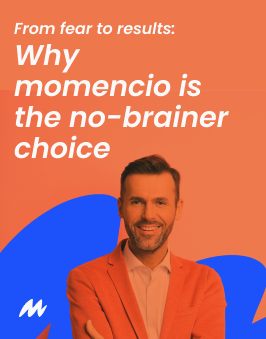
Top event sales qualification questions to ask prospects at every event
There’s a bad habit that happens at events. People either rush through conversations to scan more badges, or they let the chat drift aimlessly because they’re afraid of seeming too salesy. Neither works. What you need is flow. A natural, grounded way of leading conversations that gives prospects room to share, but quietly steers toward the insights you need to decide if they’re a real lead or just another handshake.
This is not about having a fixed script. It’s about carrying the right posture into the conversation so you can use questions as gentle guideposts. Done well, they won’t even feel like qualification questions. They’ll feel like curiosity, like you’re simply having an honest conversation about their day-to-day struggles. That’s when people let their guard down and give you the truth.
Let’s walk through this properly.
Start with a smooth diagnosis
Once you’ve got their attention and they’ve shown some genuine interest in your solution, you begin here. Your goal is to uncover the friction points in their current setup, but without sounding clinical.
“What tends to slow things down the most for you when you’re managing [insert relevant workflow]?”
This is an easy opener because it doesn’t pry. It’s not confrontational. It simply invites them to share a frustration in their own words.
“In your experience, what’s been the trickiest part of keeping [specific outcome] consistent?”
Let’s say you’re offering a lead management tool. You could say, “what’s been the trickiest part of keeping your post-event follow-ups timely and effective?” Now they’re thinking about a real problem, not just browsing.
“I often hear teams struggling with [common pain point]. Does that happen in your process too?”
This one does two things. It shows you understand their world and it invites them to say, “yes, that’s exactly it.” Now you’re having a real conversation.
Explore their current workarounds
If they’ve admitted to a challenge, this is your moment to dig a little deeper without pushing.
“How are you handling that today?”
Simple. Open. No assumptions. They’ll tell you if they’re cobbling together manual solutions or relying on systems they’re not happy with.
“When this comes up, is it usually a time drain, a budget issue, or just general frustration?”
This helps you understand the impact of the problem without asking them to spell it out.
“Have you tried any solutions so far, or are you still looking for the right approach?”
Casual, non-threatening. If they’ve tried and failed, they’ll tell you. If they’re actively looking, you’ve just uncovered serious intent.
Understand the weight of the problem
Now you ease into urgency, but without asking clunky questions like, “what’s your timeline?”
“If this continues as it is, what’s the impact over the next few months?”
This makes them think forward, makes them feel the consequences, and it helps you understand their level of pain.
“How much of a priority is this for your team right now?”
Soft, respectful, but still clear. If it’s priority number one, they’ll say so.
“There’s usually a window before this becomes too painful to ignore. Where do you see yourself on that timeline?”
It’s conversational, not scripted. It lets them self-assess without feeling cornered.
Test their level of evaluation
By now, you should have a sense of whether they’re experiencing a problem and how urgent it is. Now you want to understand if they’re actually looking for solutions.
“Are you in the stage of exploring a few options, or are you more in the early idea-gathering phase?”
This frames it gently. It gives them an easy way to self-select their buying stage.
“Are others in your team feeling this pinch too?”
If they say yes, you know it’s not just their personal frustration. It’s company-wide. That’s valuable information.
“Are you thinking about solving this internally, or are you open to external solutions?”
Again, you’re not asking if they’re buying today. You’re helping them reflect on their approach.
Close with permission-based next steps
This is where weak reps either push too hard or let the conversation fizzle. You do neither.
“Would it be helpful if I shared a few insights on how teams like yours are handling this?”
If they say yes, you have permission to deepen the conversation or follow up after the event.
“You’ve got some interesting priorities. Would you like me to send a quick recap after the event?”
Smooth. Natural. And now you’ve set up a post-event touchpoint without forcing it.
“Would it make sense to keep this conversation going after the show wraps up?”
No pressure. No assumption. Just an invitation to continue if it feels right.
The flow matters more than the form
What matters isn’t memorizing every one of these questions. What matters is the posture you carry into the conversation. You’re not an interrogator. You’re not there to tick boxes. You’re there to understand, genuinely and respectfully, if this person’s needs align with what you can offer. That clarity helps both of you.
And here’s the beauty of this approach. Even if they’re not the right fit, they’ll leave the conversation feeling like it was worth their time. You respected them. You listened. And when you follow up, you’ll have real context to work from, not just a name and a badge scan.
When you get this right, you’ll notice something strange but satisfying. Your post-event workload will feel lighter, but your results will feel stronger. Because you’ll have fewer conversations to chase, but far better ones to close.
Red flags that signal a poor-fit prospect (and what to do about them)
Not every conversation is a good conversation. You know this if you’ve spent even half a day at a busy trade show booth. But in the moment, when you’re caught up in the rhythm of the event, it’s hard to see the signs clearly. There’s energy, there’s flow, and the natural instinct is to treat every interaction like it’s worth pursuing. The truth is, it’s not.
There are subtle signals that tell you when to pull back. They’re not always obvious. No one is going to wear a sign that says, “I’m just here for the free tote bag.” But if you watch closely, you’ll see the patterns.
Let’s go through them, not as a checklist, but as real moments you’ve likely experienced.
You’re in the middle of explaining your solution, and they keep looking over your shoulder. Maybe it’s the next booth. Maybe it’s their colleague. Either way, their attention is drifting. This isn’t always rudeness. Sometimes it’s fatigue. Sometimes they were just passing by and got pulled into your orbit. Either way, this is a clear sign. If their eyes are already moving on, you should too.
They nod along with everything you say but offer no specifics in return. You mention lead capture challenges, and they smile politely but don’t volunteer their own experience. This is a polite deflection. They’re not engaged. If they were, they’d add their own frustrations to the conversation. Without that, you’re speaking into an empty room.
They respond to your soft qualification questions with vague answers. When you ask how they’re handling things today, they say, “oh, we have some systems in place.” No details. No examples. This is a classic stall. If they were feeling genuine pain, they’d have specifics. They’d tell you how frustrating it is to manage post-event data manually. They’d tell you how their team struggles to follow up quickly enough. Silence on these points tells you what you need to know.
They seem interested in only one thing: the giveaway. It’s fine to attract people with a prize or freebie, but if the moment you start to explore their challenges they steer back to, “so, how do I enter the draw?” — you’ve got your answer. Let them have the giveaway, wish them well, and move on. No guilt, no hesitation.
They focus their questions entirely on price, before you’ve even talked about value. “How much is this?” before they understand what “this” even is. Price-first conversations at this stage are rarely productive. If they don’t yet see the value, the price won’t make sense to them anyway. You’re better off spending your time with someone who cares about solving their problem, not just ticking boxes.
They say, almost too quickly, “you should talk to my colleague.” This is not always a brush-off, but you have to read the tone. If they’re genuinely looping in a decision maker, great. But if it feels like they’re deflecting without context, take it for what it is: a polite exit strategy.
They describe a setup that’s completely outside your solution’s sweet spot. Maybe they’re using systems so basic that your platform would overwhelm them. Maybe they’re in an industry you don’t serve. Whatever the reason, if the gap feels too wide to bridge, trust your gut. Not every prospect is your prospect.
What do you do when you spot these signs? You move on, and you do it with grace. Thank them for their time. Give them the dignity of a good exit. But don’t spend energy trying to turn around a dead-end conversation. Your future self will thank you.
There’s a discipline here that separates the seasoned event professional from the hopeful amateur. It’s the ability to recognise that not all conversations deserve follow-up, not all scanned badges belong in your pipeline, and not every person who stops at your booth is worth your mental bandwidth.
When you honor that discipline, you create space. Space for better conversations. Space for stronger follow-ups. Space for real opportunities that don’t just look good in the lead report but actually have a chance of becoming revenue.
And that’s the point of being here, isn’t it?
When to walk away: protecting your sales pipeline and energy
There’s an uncomfortable truth most people avoid at events. Walking away from a conversation feels like failure. It feels rude. It feels like you’re giving up on a chance that, if you just tried a little harder, might turn into something.
But it’s not failure. It’s skill.
The best event professionals understand that walking away at the right time is not a sign of weakness. It’s a mark of respect. For your time, for their time, and for the focus of your overall strategy.

Let’s break this down.
Knowing when a conversation has run its course
Every conversation has a natural arc. It begins with curiosity, moves into discovery, and if there’s a fit, it deepens into real interest. But if that arc stalls at any point — if curiosity fades or discovery yields no meaningful signals — it’s time to recognise the plateau.
You’ve asked about their challenges, and they’ve shrugged. You’ve explored their processes, and they’ve stayed vague. You’ve invited them to share priorities, and they’ve offered none. These are all signs that the conversation has run its course.
Hanging on at this point doesn’t revive the moment. It drains it further.
Dare to take the event fatigue recovery challenge?
Recognizing the cost of false hope
What keeps people lingering in dead-end conversations is hope. The idea that maybe, just maybe, this person will reveal a hidden need if you just keep talking. But hope is expensive. Every extra minute you spend here is a minute not spent with someone genuinely searching for your solution.
It’s not just the lost time during the event. It’s the follow-up emails you’ll write. The CRM notes you’ll enter. The reporting you’ll do to justify the lead. All of this adds up to hours invested in a lead that was never a lead to begin with.
Hope is not a strategy. Precision is.
Trusting your instinct, and acting on it
Good salespeople have a sense for when something isn’t landing. Great salespeople trust that sense. They know when the energy in a conversation shifts, when interest flickers out, when answers become placeholders rather than insights.
This is not a moment for awkwardness. It’s a moment for clarity.
You can close the conversation with grace. “I won’t take up more of your time, but if you ever find yourself looking to solve [pain point], I’d be happy to pick up the conversation.” No pressure. No hard sell. Just a clean exit that leaves the door open, but doesn’t waste another second.
Clearing space for better opportunities
The moment you let go of a poor-fit conversation, you make room for a better one. And that’s not just a theory. It’s practical math. At any event, your energy is finite. Your capacity for quality interaction is limited. The faster you move away from conversations that aren’t going anywhere, the more time you free up for prospects who are actively searching for answers.
It’s about respecting your pipeline as much as your prospects.
Building discipline into your event rhythm
Walking away well isn’t about a single moment. It’s about building a discipline into your entire approach to events. It’s about recognising that volume is not the goal. Velocity and value are.
When you adopt this mindset, you’ll notice a shift. Your conversations feel sharper. Your follow-ups feel more targeted. Your post-event analysis feels cleaner. You’re no longer sifting through noise to find the signals. You’ve tuned your process to hear only what matters.
And perhaps most importantly, you’ll leave the event feeling less exhausted and more accomplished. Because you didn’t chase every badge. You didn’t force every conversation. You chose quality over quantity, and your results will reflect that.
That’s the quiet power of knowing when to walk away.
Optimizing your qualification strategy for future events
Every event teaches you something. Some lessons are sharp and immediate. Others creep in quietly when you review the aftermath. You see it in the patterns of conversations that went nowhere. You see it in the weight of follow-ups that feel forced. And if you pay attention, you start to understand something crucial: your qualification strategy is not a fixed routine. It’s a living, breathing practice that sharpens with every event you work.
Start with brutal honesty
You have to look at your past events with clear eyes. Not through the lens of how many badges you scanned or how busy your booth felt, but through the clarity of outcomes. Which conversations led to meaningful follow-ups? Which prospects turned into real pipeline? Which of your pre-event assumptions about your audience held true, and which fell apart the moment you started talking to people face to face? When you start with honesty, you open the door to improvement.
Prepare beyond the surface
Real preparation goes beyond rehearsing your product pitch. Before you step onto the show floor, you should know exactly what good looks like. You should know the profile of a conversation worth pursuing, and just as importantly, the profile of one worth stepping away from. This way, you’re not improvising on the spot. You’re recognising patterns you’ve already committed to memory.
Align your tools with your strategy
Preparation isn’t just internal. It extends to your tools and systems. Whatever method you use to capture notes during conversations, whether it’s a smart scanner, an app, or old-fashioned shorthand, make sure it serves your ability to qualify leads in real time. Your post-event process should not be a guessing game. It should be a reflection of the clarity you had at the moment of capture. If you’re waiting until you’re back at your desk to figure out which leads matter, you’re already too late.
Refine your approach after every event
Refinement happens in small moments. Maybe you notice that one particular opening question consistently unlocks useful information. Maybe you find that rephrasing a certain prompt helps prospects open up about their pain points. Pay attention to these details. Carry them forward. Build them into your rhythm. Qualification is not a static checklist. It’s an evolving conversation between you and your market.
Think about your future self
Most importantly, remember that your qualification strategy should always be in service of your future self. Think about the person you’ll be in the days after the event, staring at a long list of names and trying to make sense of them. Will you be grateful for the clarity you built into your conversations? Will you be confident about where to focus your energy? Or will you feel the familiar frustration of chasing ghosts?
Play offense, not defense
If you do this well, something changes. You stop treating qualification as a defensive tactic to avoid bad leads and start seeing it as an offensive play to build a sharper, cleaner pipeline. You stop dreading follow-ups and start looking forward to them. You stop measuring events by volume and start measuring them by velocity. And in that shift, you unlock the real value of your event investment.
Qualification isn’t just what happens in the moment. It’s the strategy you carry forward, sharpen, and bring back stronger every time.
Conclusion
There’s a quiet satisfaction in knowing you walked into an event with a plan and walked out with clarity. Not a pile of leads to untangle, not a bloated list of names that feels like work for tomorrow, but a handful of real conversations you can build on. This is what sharp event sales qualification delivers. It strips away the noise. It clears the fog.
What we’ve talked about here isn’t theory. It’s the work of paying attention. It’s the discipline of knowing when to pursue and when to let go. It’s understanding that qualification isn’t an add-on to your event strategy — it is your strategy. Everything else is just logistics.
Because at the end of the day, an event is a pressure cooker of decisions. Fast conversations, split-second judgments, constant motion. Without a clear qualification mindset, it’s too easy to let the energy of the event pull you into busywork disguised as progress. But when you carry this clarity with you, you see through the noise. You spot the signals that matter. You protect your time and energy for the prospects who deserve it.
And here’s what happens next. Your post-event follow-up becomes sharper. Your pipeline feels lighter, cleaner, more focused. You no longer dread the follow-up calls and emails because you know you’re reaching out to people who actually cared about the conversation. People who gave you honest signals of interest, people you qualified with precision, people who are worth the pursuit.
This is the quiet, professional edge that separates a crowded booth from a productive one. It’s not the giveaways. It’s not the light show. It’s not even the traffic to your booth. It’s your ability to qualify, right there in the moment, with grace and purpose.
Carry this approach into your next event. Treat qualification as your first job, not your afterthought. Respect the time of your prospects as much as you respect your own. And when the event ends, you’ll feel it in your bones — the difference between spinning your wheels and actually moving forward.
That’s the path to smarter event sales qualification. And it’s one well worth walking.
If you’re ready to qualify leads smarter and capture real conversations that convert, take a look at how momencio can help. Book your demo today.
FAQs
- How do I qualify leads quickly without rushing the conversation?
- You do it by knowing exactly what you’re listening for before the conversation even starts. Go in with a clear mental map of the pain points and signals that matter most to your solution. Then, guide the conversation naturally toward those areas. You’re not hurrying them along, you’re steering the dialogue to uncover what’s real. It feels like a normal conversation, but beneath the surface, you’re efficiently figuring out if they’re a fit.
- What’s better: qualifying during the event or after?
- Always during the event. Post-event qualification is too late. When you’re face to face, you have their attention, their energy, and the fresh context of their situation. Wait until after, and you’re guessing based on notes or badge data, which are never enough. Real qualification happens in the flow of conversation, while the moment is alive. Anything after that is just sorting names, not truly qualifying.
- How do I politely move on from a conversation that’s going nowhere?
- You acknowledge their time, thank them genuinely, and offer a natural close. Something simple like, “I won’t keep you longer, but if you ever find yourself looking to improve [pain point], I’d be happy to pick this up again.” No awkwardness, no pressure. It leaves the door open if they come around later but protects your time and energy for better opportunities on the floor.
- Is it risky to disqualify too aggressively at events?
- The risk isn’t in disqualifying. The risk is in clinging to conversations that don’t belong in your pipeline. If you disqualify thoughtfully — based on real signals, not assumptions — you’re actually doing both sides a favour. You’re not wasting their time, and you’re not wasting yours. Remember, qualification isn’t rejection. It’s clarity. Done well, even disqualified prospects leave the conversation with respect for your professionalism.
- How can I make sure my whole team qualifies leads consistently?
- It starts with alignment before the event. Make sure everyone is clear on what a good lead looks like, what key signals to listen for, and how to handle conversations that don’t fit. Share examples. Run quick role-plays. But most importantly, remind the team that qualification is about respect — for their own time, and for the prospects’. When the team carries that mindset, consistency follows naturally.
Interesting facts from research
- Approximately 72% of exhibitors attend trade shows to gain new leads.
- Only 6% of exhibitors are confident in their ability to convert trade show leads into actual sales.
- Nearly 50% of trade show attendees hold executive or upper management roles.


